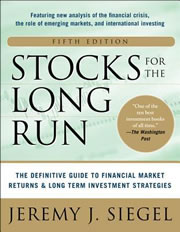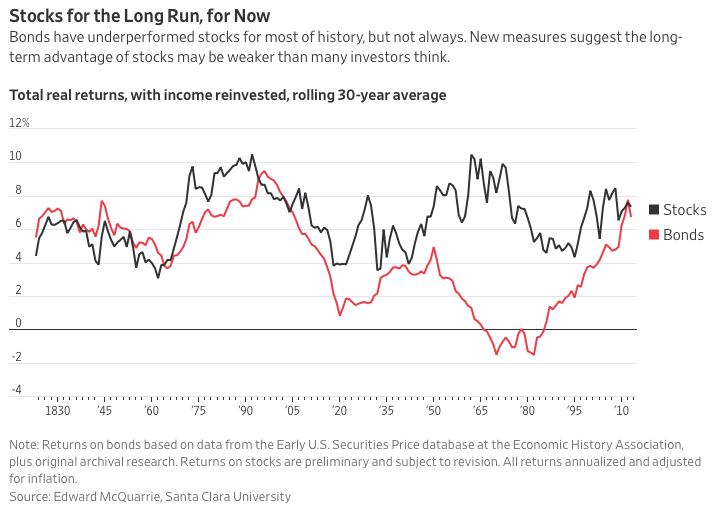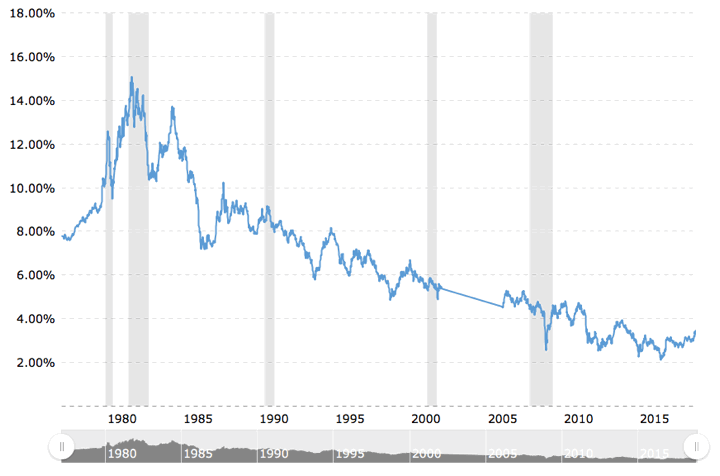 When it comes to news, the headline “man bites dog” will get people’s attention, not “dog bites man”. Similarly, a new research paper that questions the idea of “Stocks for the Long Run” will create headlines like the WSJ article Sometimes, It’s Bonds For the Long Run (paywall?) by Jason Zweig.
When it comes to news, the headline “man bites dog” will get people’s attention, not “dog bites man”. Similarly, a new research paper that questions the idea of “Stocks for the Long Run” will create headlines like the WSJ article Sometimes, It’s Bonds For the Long Run (paywall?) by Jason Zweig.
Prof. McQuarrie has compiled a new database of US bond prices dating all the way back to 1823, including longer-term federal, municipal, and corporate bonds. During this early period, he found that bond returns were much closer to stock returns than from 1900 onward. The WSJ included this chart of rolling 30-year average returns:

Assuming the data is accurate, the returns between US stocks and US bonds from 1823-1900 do look very similar, even somewhat correlated. I don’t know what it was like in the 1800s to buy a share of a company vs. buying a debt instrument. I imagine the environment was very different and that very few average households participated.
However, I also noticed how the 30-year average returns for stocks rarely dipped much below 4% real return over the past 200 years. If you’re telling me to look back at history, that’s also a crazy finding in my opinion. In contrast, holding onto bonds that averaged a negative real return over 30 years? Yikes.
The WSJ article also points out that 30-year Treasury bonds outperformed stocks as recently as from 1981 to 2011. But then I looked up this chart of historical 30-year Treasury yields:

The 30-year Treasury had a yield of about 14% back in 1981. Check out this 1981 NY Times article 30-YEAR U.S. BONDS HIT 15%. The decades-long bull run for bonds fueled by continuously dropping rates doesn’t have much room to go lower. The 30-year Treasury today is 3.35%.
Now, look at the first chart again and notice where the bond returns were negative from 1950 to 1980. The 30-year Treasury didn’t exist in 1950, but the 10-year Treasury equivalent yield in 1950 was about 2%. In 1950, corporate bonds yielded about 3%. Sound familiar? That’s about the same rates as today, so it’s hard to get too excited about long-term bond returns at this point.
It’s an interesting paper to read, but I don’t see anything that would change my portfolio outlook overall. I hold 2/3rd stocks and 1/3rd bonds, which is probably a lot more bonds than is usually recommended for someone my age, but I am also much closer to living off of my portfolio than most people my age. Bonds and cash are important components and everyone should probably own some. Still, if you made me pick, I’d bet on “Stocks for the Long Run”.
 The Best Credit Card Bonus Offers – 2025
The Best Credit Card Bonus Offers – 2025 Big List of Free Stocks from Brokerage Apps
Big List of Free Stocks from Brokerage Apps Best Interest Rates on Cash - 2025
Best Interest Rates on Cash - 2025 Free Credit Scores x 3 + Free Credit Monitoring
Free Credit Scores x 3 + Free Credit Monitoring Best No Fee 0% APR Balance Transfer Offers
Best No Fee 0% APR Balance Transfer Offers Little-Known Cellular Data Plans That Can Save Big Money
Little-Known Cellular Data Plans That Can Save Big Money How To Haggle Your Cable or Direct TV Bill
How To Haggle Your Cable or Direct TV Bill Big List of Free Consumer Data Reports (Credit, Rent, Work)
Big List of Free Consumer Data Reports (Credit, Rent, Work)
Hi Jonathan,
I was wondering if you have information on buying CDs or similar very short term (1 year or less) bonds inside a brokerage IRA? If I were to buy a 1-year CD inside the IRA, would the whole operation be similar to how it’s conducted at, say, Ally Bank?
—TIA, Harish
If 30 year rates were 14% again, would you just go with long bonds? 😀
I wouldn’t go only with long bonds, but I’d like to think I would keep an open mind. 🙂 If you read the NYT article in 1981, it’s not like everyone said “oh my gosh the rates are so high we need to back the truck up!”. Businesses were hoping to get financing at 17% and not getting any interest. On the way, rates hit 6%, 8%, 10%, 12%, 14%. Inflation was high, and bond investors had just lost a ton of money due to the rising rates.
Nick Murray in his book ‘Simple Wealth, Inevitable Wealth’ speaks to bonds vs equities long term. Very, very good read.